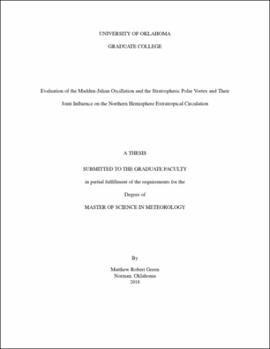| dc.description.abstract | Multiple modes of climate variability inform long-range Northern Hemisphere (NH) winter weather prediction through their interactions with the atmosphere. Two specific modes of variability that are the focus of this study are: (1) the state of the stratospheric polar vortex (SPV) and (2) the Madden-Julian Oscillation (MJO). The stratospheric polar vortex is a phenomenon whose variability can influence the NH polar jet stream. The MJO's enhanced tropical convection can perturb Rossby waves that propagate poleward, vertically, and zonally along the jet stream, interacting with the extratropical atmosphere. While these climate modes and their influence on winter weather patterns have been studied separately, their joint relationship and its interaction with the wintertime extratropical circulation remains undetermined.
This study analyzes the combined influence of the NAM$_{100}$ and the MJO on NH subseasonal to seasonal winter weather patterns. Using the ERA-Interim dataset, the study analyzes a series of conditional composites of outgoing longwave radiation (OLR) MJO index (OMI) during neutral SPV state, strong/weak SPV during weak OMI, and joint OMI and SPV events. Neutral state of the SPV and weak state of the MJO refer to event that occur when these indices have very low amplitude. We find that the MJO maintains control of the pattern primarily in the Pacific Basin. The SPV, on the other hand, has a stronger influence on tropospheric patterns over the North Atlantic and Europe. Extended-range predictability of weather patterns over the Eastern US, for example, could result in significant forecast error if only using the SPV as a predictor compared to using both the MJO and the state of the SPV together. Analyzing the joint composite also produces signals of constructive and destructive interference between these two modes. For example, when the OMI is in phases 7 \& 8 (7 \& 8) during weak (strong) SPV, strong constructive (destructive) interference results, with enhanced positive height anomalies over the Arctic and strong annular negative anomaly pattern.
Dynamical analysis of propagating waves, using Eliassen-Palm (EP) flux, show stratosphere-troposphere interactions change with the influence of the MJO-SPV relationship. OMI 7,8 (2,3,4) and SPV events are observed to increase (decrease) the anomalous upward propagation of Rossby waves into the stratosphere. Through the composite analysis it is assumed that the two modes work independently of one another to influence extratropical patterns. However, we investigate whether this assumption holds true, analyzing the MJO's influence on the stratosphere-troposphere relationship. Our results show that during the period of composite analysis (+10-14 days after event) the MJO influences patterns most strongly in the troposphere. Through observing the changes in the NAM through the stratosphere and troposphere, OMI 7,8 (2,3,4) during neutral SPV influence negative (positive) changes in the NAM index upward through the troposphere and into the stratosphere. These OMI events during neutral SPV events do not depict the initiation of stratospheric events, showing a lack of downward propagation of the anomalous NAM signal into the troposphere.
This study provides an understanding of the processes of the MJO-SPV relationship to improve S2S forecasting for NH extratropical winter weather patterns. OMI and SPV joint events show that, compared to individual events, variability of the weather patterns +10-14 days after events are decreased, thereby potentially increasing the predictability of NH weather patterns on S2S timescales. Implications for climate modeling are also found here, through providing consistent patterns of dynamical processes for model verification. Valuable predictability of S2S weather patterns is available through using only the MJO and the SPV congruently to forecast winter weather patterns in the NH. | en_US |
